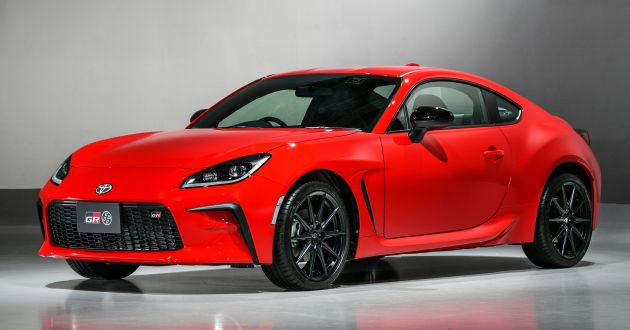Here it is, the new Toyota GR 86, which is the close sibling to the second-generation Subaru BRZ that was revealed last November. Born out of the renewed and ongoing partnership between Toyota and Subaru, the GR 86 is scheduled to go on sale in Japan this autumn, joining the GR Supra and GR Yaris in the big T’s GR series of sports cars. It will also be launched in Europe later on.
Design-wise, everything about the GR 86 from the bonnet to its tail are pretty much identical to the BRZ, although this red example does come with black-painted side mirror caps and wheels in a darker hue (these are paired with Michelin Pilot Sport 215/40 tyres).
As with the BRZ, the GR 86’s architecture adopts elements from the Subaru Global Platform, so there’s 50% more torsional rigidity than before, thanks to a reinforced chassis mounting system. The dimensions are identical too, with the GR 86 measuring 4,265 mm (+25 mm) long, 1,775 mm wide, 1,310 mm (-10 mm) tall, while the wheelbase is up by five mm to 2,575 mm.


Like the original Toyobaru duo (first-gen BRZ and 86/GT86/Scion FR-S), the main differentiator between the two is seen at the front. The GR 86 gets its own bumper design that features what the company calls a functional “Matrix Grille,” which is flanked by L-shaped trim pieces framing the corner air ducts.
As the side-by-side comparison photo shows, the BRZ’s grille is hexagonal in shape, while its side inlets are styled to be a lot more prominent. Beyond the bumpers, the GR 86 also sports teardrop-shaped headlamps with integrated C-shaped LED daytime running lights, functional side vents, C-shaped taillights, a ducktail spoiler on the boot lid and a “double bubble” roof.
Again, these cues are the same on the BRZ, and the same applies to the interior as well. The GR 86’s cabin also gets the Subaru’s dashboard, which has a flat section ahead of the front passenger, circular corner air vents as well as rectangular centre vents. The steering wheel (with GR branding), infotainment system, digital instrument cluster and piano-key/dial switches for the HVAC system are all the same as well.
Under the bonnet, the GR 86 is powered by a 2.4 litre naturally-aspirated flat-four petrol engine that makes 235 PS at 7,000 rpm and 250 Nm of torque at 3,700 rpm (slightly more than the USDM BRZ). Drive is sent to the rear wheels via a six-speed manual or automatic transmission, and Toyota claims a zero to 100 km/h time of 6.3 seconds, which is 1.1 seconds less than the outgoing model. This isn’t surprising, as the previous 86 used a 2.0 litre NA flat-four with 207 PS (200 PS with the automatic) at 7,000 rpm and 212 Nm from 6,400 to 6,600 rpm.
Other technologies of the FA24D include Toyota’s D-4S direct and port injection system, along with double overhead chain-driver camshafts, four valves per cylinder, and dual Active Valve Control System (DAVCS) to control valve timing on the intake and exhaust.
No official pricing in Japan just yet, but Toyota says the automatic version will come with Subaru’s EyeSight suite of driver assistance systems, including pre-collision safety technologies. Now that you’ve seen the new-age Toyobaru duo, which one do you find more appealing?










GALLERY: Toyota GR 86 (Europe market) 



The post 2021 Toyota GR 86 debuts in Japan – 2.4L NA flat-four with 235 PS and 250 Nm; six-speed auto and manual appeared first on Paul Tan's Automotive News.




0 Comments